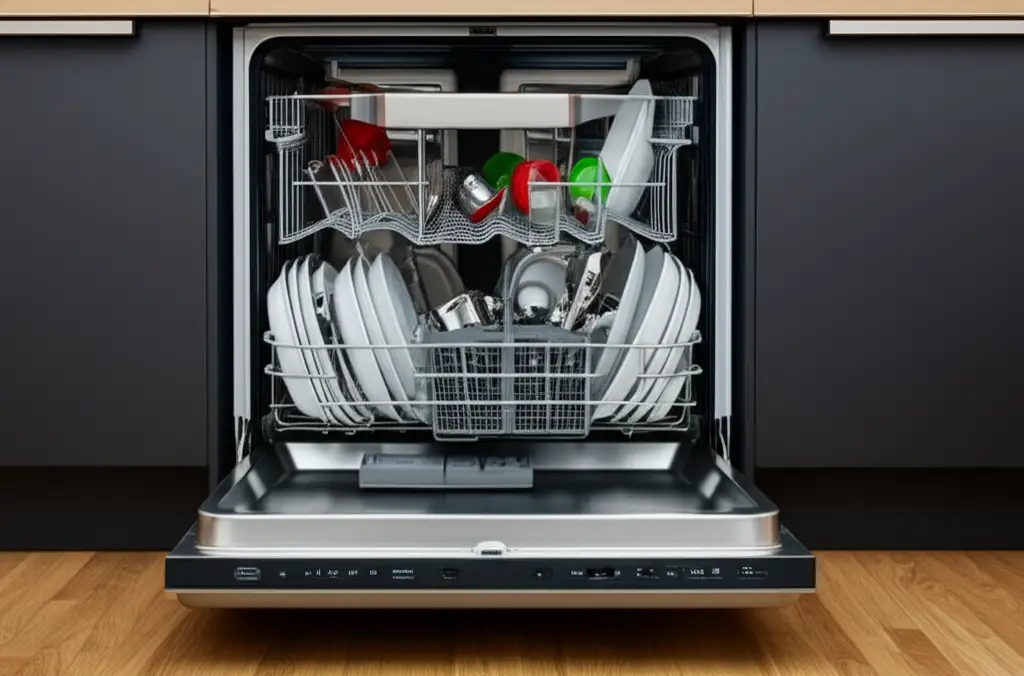· Mason Everett · Kitchen Appliances · 22 min read
How Much Space Do You Need For A Dishwasher

How Much Space Do You Need For Your Dishwasher?
Finding the right spot for a new dishwasher can feel like solving a puzzle. You might wonder, “Exactly how much space do you need for a dishwasher?” This question is crucial for any kitchen renovation or appliance upgrade. Proper planning ensures a smooth installation and a well-functioning kitchen. I understand the importance of getting these measurements right the first time.
This guide will break down all the necessary space considerations. We will cover standard dimensions, explore options for smaller kitchens, and discuss vital utility clearances. You will learn about installation specifics and the impact of kitchen design. My aim is to help you confidently select and install your ideal dishwasher.
Takeaway:
- Standard Built-in Dishwashers: Typically require a 24-inch wide, 24-inch deep, and 34-inch high opening.
- Compact Dishwashers: Need less space, often around 18 inches wide.
- Portable Dishwashers: Offer flexibility, but consider storage space when not in use.
- Utility Clearances: Account for water lines, drain hoses, and electrical connections behind the unit.
- Door Clearance: Ensure ample space for the dishwasher door to fully open without obstruction.
The typical space you need for a built-in dishwasher is a cabinet opening 24 inches wide, 24 inches deep, and 34 to 35 inches high. However, compact, portable, and countertop models offer varied dimensions to suit diverse kitchen layouts and personal needs. Always measure your available space precisely before purchasing.
Understanding Standard Dishwasher Dimensions
When you think about a dishwasher, a standard size usually comes to mind. These dimensions are crucial for built-in models, which fit under your kitchen counter. Knowing these measurements helps you plan your kitchen layout effectively. I always recommend measuring your existing space before shopping.
Standard Built-in Dishwasher Measurements
Most built-in dishwashers adhere to specific size requirements. This consistency makes it easier for manufacturers and homeowners. The width is the most critical measurement for these units. You will find that most models fit into a common opening.
- Width: The industry standard for built-in dishwashers is 24 inches. This means you need a cabinet opening that is at least 24 inches wide. Some installers might recommend a tiny bit more, like 24 and 1/8 inches, for easier sliding.
- Depth: Standard depth is typically 24 inches. This allows the dishwasher to sit flush with your kitchen cabinets. Remember, this depth does not include the handle or door protrusion.
- Height: The height usually ranges from 34 to 35 inches. This measurement ensures the dishwasher fits snugly under a standard countertop. Many models have adjustable legs, which help you level the unit and achieve a perfect fit.
These standard sizes ensure compatibility across different brands and kitchen designs. Always double-check these measurements with your chosen appliance. Variations can exist, so careful reading of product specifications is important. This practice prevents installation surprises later on.
Why Standard Sizes Matter
Standard sizing simplifies kitchen design and appliance replacement. When you know common dimensions, you can easily plan for a new unit. Replacing an old dishwasher becomes straightforward. You do not need to alter your existing cabinetry. This saves time and money on renovations.
For new constructions, architects and builders rely on these standards. They design kitchen layouts with dedicated spots for these appliances. This predictability is a huge advantage for everyone involved. It makes the entire process more efficient. Understanding standard dimensions is the first step in successful dishwasher integration.
Exploring Dishwasher Types and Their Space Needs
Not all kitchens are the same size, and neither are all dishwashers. You have several options beyond the standard built-in model. Each type offers unique benefits and different space requirements. Understanding these variations helps you choose the best fit for your home. I find that many people overlook these alternatives.
Compact and Slimline Dishwashers
If your kitchen has limited space, a compact or slimline dishwasher can be a fantastic solution. These units are designed for smaller households or apartments. They offer the convenience of a dishwasher without needing a large footprint. Their narrower design is their key feature.
- Width: Compact dishwashers are typically 18 inches wide. This is a significant reduction from the standard 24 inches. This smaller width allows them to fit into tight spaces. You might find them in smaller homes or secondary kitchens.
- Depth: The depth remains similar to standard models, around 24 inches. This helps them align with regular cabinet depths.
- Height: Heights are also comparable, usually between 34 and 35 inches. They still fit under standard countertops.
These models handle fewer dishes per load but are perfect for one or two people. They use less water and energy, which is a bonus. Consider these if your kitchen simply cannot accommodate a full-sized unit.
Portable Dishwashers
Portable dishwashers offer incredible flexibility. They do not require permanent installation or dedicated under-counter space. You can roll them to your sink for use and then store them away. This is ideal for renters or homes without built-in dishwasher plumbing.
- Dimensions: Portable units come in both 24-inch and 18-inch widths. Their depth and height are generally similar to their built-in counterparts. However, remember to factor in space for the hoses and the electrical cord when in use.
- Storage Space: The most important space consideration for a portable dishwasher is where you will store it. You need a clear area in your kitchen or utility room. This space must be accessible and large enough for the unit to sit comfortably. You also need room to maneuver it to the sink.
Portable models connect to your kitchen faucet for water and drain into the sink. They are a great temporary or flexible option. I have seen many people use these successfully in older homes.
Countertop Dishwashers
For extremely small spaces, a countertop dishwasher might be the answer. These are the most compact options available. They sit directly on your kitchen counter, much like a microwave.
- Dimensions: Countertop dishwashers are much smaller than other types. They are typically around 17-22 inches wide, 17-22 inches deep, and 17-22 inches high. Their small size means they fit in a variety of spots.
- Counter Space: You need dedicated counter space for these units. They also require proximity to a sink for water connection and drainage. They are suitable for single individuals or those who only wash a few dishes daily.
Each dishwasher type serves a different need. Your choice depends on your kitchen size, household needs, and budget. Measure your available space carefully before deciding. This ensures your new appliance fits perfectly into your home.
Crucial Clearances and Utility Requirements
Installing a dishwasher involves more than just sliding it into a cabinet opening. You must account for vital clearances and utility connections. Overlooking these details can lead to installation headaches or even damage. I always stress the importance of pre-planning these elements. These are the hidden space demands for a dishwasher.
Water Line and Drain Hose Clearance
Your dishwasher needs to connect to your home’s plumbing system. This requires space behind the unit for the water inlet line and the drain hose. These hoses are flexible, but they still occupy volume. They cannot be kinked or crushed.
- Behind the Unit: Allow at least 2-4 inches of clear space behind the dishwasher for these connections. This space is usually part of the standard 24-inch depth requirement. However, ensure no pipes or wires protrude excessively from the wall. Proper installation also means understanding the plumbing needs. For specific details on appliance plumbing, you might find information on what plumbing do you need for a washing machine helpful, as basic concepts for water supply and drainage are similar.
- Under the Sink: The drain hose typically connects to the air gap on your sink or a garbage disposal unit. Ensure there is enough room under your sink for these connections. The hose should slope downwards to allow proper drainage. Kinks in the drain hose can prevent your dishwasher from working correctly. If you ever have issues with your dishwasher not draining, understanding the connection points is key to how to get the dishwasher to drain.
These clearances ensure proper water flow and efficient drainage. Without them, your dishwasher cannot operate as intended.
Electrical Outlet and Wiring Space
A dishwasher requires a dedicated electrical circuit and outlet. This outlet is usually located in an adjacent cabinet, often under the sink. It needs to be easily accessible for maintenance or emergencies.
- Adjacent Cabinet Access: The electrical outlet should not be directly behind the dishwasher. Placing it there could prevent the dishwasher from sliding all the way back. Instead, locate it in the cabinet next to the dishwasher or underneath the sink.
- GFCI Requirement: Many local codes require a Ground Fault Circuit Interrupter (GFCI) protected receptacle for dishwashers. This is a safety measure. You need to ensure you have enough space for this specialized outlet. If you are curious about specific electrical requirements, you can learn more about whether a dishwasher receptacle needs to be GFCI.
- Wire Length: The electrical wire from the outlet to the dishwasher must have enough slack. This allows the unit to be pulled out for service if needed. Do not stretch or tightly pull the wiring.
Proper electrical setup is vital for safety and function. Always consult with a qualified electrician if you are unsure about your home’s wiring.
Door Opening Clearance
This often-overlooked clearance is essential for daily use. Your dishwasher door needs to open fully to load and unload dishes easily. You must ensure no obstructions are in its path.
- Front Clearance: Allow at least 25-30 inches of clear space in front of the dishwasher. This measurement provides room for the door to open completely. It also gives you comfortable space to stand and access the racks.
- Adjacent Cabinets/Appliances: Check if cabinet doors, oven doors, or refrigerator doors will interfere with the dishwasher door. You do not want two appliance doors to collide when opened. Plan your kitchen layout to avoid such conflicts.
Consider your personal comfort when thinking about door clearance. You want enough room to maneuver dishes, not just open the door. Proper clearances ensure your dishwasher is both functional and convenient to use.
The Impact of Kitchen Layout and Design
The overall design of your kitchen plays a significant role in where your dishwasher can go. A well-thought-out layout maximizes efficiency and ensures your appliances fit seamlessly. I always consider the workflow when planning a kitchen space. This includes the “work triangle” concept.
The Kitchen Work Triangle
The “work triangle” refers to the ideal layout for your sink, refrigerator, and stove. These are the three most used areas in a kitchen. The goal is to minimize steps between them. Your dishwasher should ideally be near the sink.
- Proximity to Sink: Placing the dishwasher right next to the sink is highly practical. This makes rinsing dishes and loading them quick and easy. Most dishwashers connect to the sink’s water supply and drain. This proximity simplifies the plumbing installation.
- Workflow Efficiency: A dishwasher near the sink means less dripping across the floor. You can scrape food into the sink, rinse, and load directly. This creates a smooth flow from dirty dishes to clean ones. It significantly improves kitchen functionality.
When planning your kitchen, consider how you move between these points. The dishwasher should enhance this flow, not hinder it.
Cabinetry and Countertop Considerations
Your existing or planned cabinetry will dictate the available space for a dishwasher. Standard cabinets are designed to accommodate standard appliance sizes. However, custom cabinetry or older kitchens might require adjustments.
- Cabinet Modifications: If your space is too narrow or too wide, you might need to modify your cabinets. This could involve adding a filler strip or cutting down a cabinet. Always consult a professional for cabinet modifications. Incorrect alterations can compromise structural integrity.
- Countertop Overhang: Countertops typically have a slight overhang at the front. Ensure this overhang does not impede the dishwasher door from opening. Most standard installations account for this, but it is worth checking. The height of your countertop also impacts the dishwasher’s fit. Dishwashers usually have adjustable legs to accommodate slight variations in counter height.
Integrated or panel-ready dishwashers require specific cabinetry. These units blend into your kitchen by having a custom panel attached to their front. This style demands precise measurements for the panel.
Noise Considerations and Insulation
Dishwashers can generate noise during operation. While not directly a space requirement, it is a factor in appliance placement. Some dishwashers are quieter than others.
- Decibel Levels: Check the decibel (dB) rating of the dishwasher you are considering. Lower numbers mean quieter operation. If your kitchen is open to a living area, a quiet dishwasher is beneficial.
- Insulation: Modern dishwashers often come with built-in insulation for noise reduction. However, additional insulation around the dishwasher cavity can further dampen sound. You might wonder, does a dishwasher need insulation around it? While not strictly necessary for all models, it can greatly improve your home’s comfort by reducing operational noise. Consider this if noise is a concern in your kitchen.
Thinking about noise helps create a more comfortable home environment. It is an often-overlooked aspect of kitchen design. A well-designed kitchen considers all these elements for optimal function and comfort.
Installation Best Practices for Optimal Fit
Installing a dishwasher correctly ensures it operates efficiently and lasts longer. Proper installation involves more than just sliding the unit into its designated spot. It requires careful attention to leveling, securing, and connecting utilities. I have seen many issues arise from improper installation, so paying attention to details is key.
Leveling the Dishwasher
A perfectly level dishwasher is crucial for proper drainage and quiet operation. Most dishwashers come with adjustable legs for this purpose. You will need a level to ensure accuracy.
- Adjusting Legs: Before pushing the dishwasher into the opening, adjust its front and rear legs. You can often do this with a wrench or by hand. Aim for the unit to be perfectly level from side to side and front to back.
- Stability: A level dishwasher prevents internal components from being strained. It also helps the door close and seal correctly. An unleveled unit can lead to water leaks or excessive noise during cycles.
Taking the time to level the appliance properly saves future headaches. It contributes significantly to the dishwasher’s lifespan and performance.
Securing the Dishwasher in Place
Once leveled, the dishwasher needs to be securely fastened to prevent it from tipping forward. This is especially important when you pull out the racks. There are two common methods for securing it.
- Side Mounting: Many dishwashers have brackets on their sides. These brackets attach to the adjacent cabinet walls with screws. This is a common method for installations where the countertop material is sensitive, like granite or quartz.
- Top Mounting: Other dishwashers have brackets on top that screw into the underside of the countertop. This method is preferred when side access is difficult or when the dishwasher opening is slightly wider. Always pre-drill pilot holes to prevent wood splitting.
Make sure the screws are tight and the unit is stable. A properly secured dishwasher does not wobble or move when you open its door. This prevents damage to the unit and your cabinets.
Connecting Water, Drain, and Electrical
This is where the utility clearances become critical. All connections must be secure and free of kinks or leaks. If you are doing this yourself, read your dishwasher’s manual carefully.
- Water Supply: Connect the hot water supply line to the dishwasher’s inlet valve. Use plumber’s tape or pipe thread sealant on the threads to prevent leaks. Ensure the water shut-off valve is easily accessible.
- Drain Hose: Connect the drain hose to your sink’s air gap or garbage disposal. Ensure the hose has a high loop to prevent dirty water from flowing back into the dishwasher. This high loop is a critical detail for hygiene and function.
- Electrical Connection: Depending on your model, this could be a plug-in cord or a direct wire connection. If direct wiring, ensure the power is off at the circuit breaker. Follow local electrical codes and the manufacturer’s instructions. If you are unsure, hire a qualified electrician.
After all connections are made, slowly turn on the water supply and check for leaks. Then, turn on the power and run a test cycle. This confirms everything is working correctly before you finalize the installation. Proper installation ensures your dishwasher performs its best.
Maximizing Space in Small Kitchens
Small kitchens present unique challenges when integrating major appliances. However, smart design and appliance choices can help you maximize every inch. I believe that even the smallest kitchen can be highly functional. It just requires careful planning and a bit of creativity.
Strategic Appliance Placement
In a small kitchen, every appliance placement decision matters. You need to think about how each unit affects the overall flow and usability of the space.
- Consider Traffic Flow: Ensure the dishwasher door does not block walkways or other essential appliances when open. For example, avoid placing it directly across from an oven or refrigerator if their doors would collide.
- Optimize Near the Sink: Even in a small space, prioritize placing the dishwasher adjacent to the sink. This maintains the efficient work triangle and simplifies plumbing. If direct adjacency is impossible, ensure a small counter space separates the two, allowing for dish staging.
- Vertical Space: Look up! While dishwashers are floor-bound, consider how surrounding cabinets can maximize storage above. Use wall cabinets or open shelving to store dishes that will go into the dishwasher, making the loading process smoother.
Smart placement makes a small kitchen feel much larger and more functional. It is all about thinking through your daily routines.
Built-in vs. Portable Solutions
The choice between a built-in and a portable dishwasher is even more critical in compact kitchens. Each has its pros and cons regarding space utilization.
- Built-in Slimline: An 18-inch slimline built-in dishwasher is often the best choice for very small kitchens where a permanent solution is desired. It frees up counter space and does not require storage elsewhere. It integrates seamlessly into the cabinetry, creating a clean look.
- Portable Flexibility: If you cannot modify your cabinets or need extreme flexibility, a portable dishwasher is excellent. It can be rolled into a corner or pantry when not in use. This keeps your limited counter and floor space clear. Remember its storage location must be easily accessible.
- Countertop Option: For the absolute smallest spaces, a countertop dishwasher uses minimal floor space. It requires dedicated counter space, but it is often the only option for single people or those with very few dishes. This unit still needs to be near a sink for hookup.
Weigh the pros and cons of each type based on your kitchen’s specific layout and your lifestyle.
Custom Solutions and Design Tricks
Sometimes, standard solutions are not enough. Custom design can unlock hidden potential in tiny kitchens. I love seeing how clever design can transform a small area.
- Custom Cabinetry: If renovating, consider custom cabinetry designed specifically for an 18-inch dishwasher. This ensures a perfect fit and maximizes surrounding storage. You can even incorporate a pull-out cutting board above it for extra workspace.
- Integrated Appliances: For a seamless look, consider an integrated dishwasher. These units accept a custom cabinet panel, making them blend invisibly with your kitchen design. This can make a small kitchen appear larger and less cluttered.
- Multi-functional Zones: Create zones in your kitchen where different tasks occur. Your dishwashing zone can be compact but efficient. Think about pull-out trash bins next to the dishwasher for easy scraping.
- Smart Storage: Use compact dish racks or dish drainers that can be folded or put away when not in use. Maximizing vertical storage for dishes near the dishwasher reduces the need for large counter drying areas.
Maximizing space in a small kitchen is about thoughtful design and choosing the right appliance. Every decision contributes to creating a functional and enjoyable cooking environment.
Advanced Considerations and Future Planning
Thinking beyond immediate installation can save you trouble down the road. Future-proofing your kitchen space for a dishwasher involves considering maintenance, potential upgrades, and overall appliance longevity. I always encourage clients to think long-term when making home improvement decisions.
Ease of Access for Maintenance and Repairs
Dishwashers, like all appliances, occasionally require maintenance or repairs. Ensuring easy access is crucial for these tasks. This relates directly to the space around and behind the unit.
- Service Access: When planning the space, ensure you can pull the dishwasher out without too much difficulty. This allows technicians to access the back of the unit for plumbing or electrical work. Do not box it in too tightly.
- Front Panel Access: Many repairs and cleaning tasks, such as filter cleaning, are done from the front. Ensure the door opens fully and you have comfortable standing room in front of the unit. Regular cleaning, like knowing how often should you clean your dishwasher filter, is simplified with good access.
- Surrounding Clearance: Avoid permanent fixtures or heavy objects directly in front of or immediately next to the dishwasher. This would make it hard to move the appliance for service.
Planning for future maintenance helps prevent costly service calls and makes repairs quicker and less intrusive.
Future Appliance Upgrades
Technology in home appliances constantly evolves. Your current dishwasher might be perfect now, but you might want to upgrade in the future. Considering this during initial planning is smart.
- Standardized Openings: Sticking to standard 24-inch openings for built-in dishwashers is the safest bet. This ensures that a wide range of future models will fit into your existing space. You won’t need to modify cabinetry every time you replace the appliance.
- Utility Locations: Position your electrical outlet and plumbing connections in standard, accessible locations. This means future dishwashers can easily connect without needing extensive re-piping or re-wiring.
- Flexible Design: If possible, design the area around your dishwasher with some flexibility. For instance, removable filler strips can accommodate slight variations in future appliance widths or allow for easier removal.
Thinking about future upgrades protects your investment in your kitchen. It means less hassle and expense when it’s time for a new appliance.
Considerations for Tub Material and Noise
While not directly space-related, the type of dishwasher you choose can impact your overall kitchen experience, especially in terms of noise and long-term durability. These factors can subtly influence how you perceive the “space” around the appliance.
- Tub Material: Dishwashers come with either plastic or stainless steel tubs. Stainless steel tubs are generally more durable, retain less odor, and can offer better sound dampening. When considering your new appliance, you might ask, do I need a stainless steel tub dishwasher? This choice can affect how quiet your kitchen is when the dishwasher is running.
- Noise Levels: As mentioned earlier, noise can be a significant factor, especially in open-concept homes. Higher-end models often have better insulation and quieter motors. This reduces the need for extra external sound dampening. A quieter appliance means the “space” it occupies feels more peaceful.
- Energy Efficiency: Newer models are often more energy-efficient, using less water and electricity. While not directly about physical space, this efficiency affects your home’s overall operational “space” in terms of resource consumption.
Considering these advanced factors ensures your dishwasher not only fits physically but also contributes positively to your home environment in the long run.
FAQs About Dishwasher Space
What is the standard rough opening for a dishwasher?
The standard rough opening for a built-in dishwasher is 24 inches wide, 24 inches deep, and 34 to 35 inches high. These dimensions accommodate most full-size residential dishwashers. Always measure your specific appliance and compare it to your available cabinet space. This ensures a proper and snug fit for the unit.
Can I install an 18-inch dishwasher in a 24-inch opening?
Yes, you can install an 18-inch compact dishwasher in a 24-inch opening. You will need to use filler strips on either side of the dishwasher. These strips cover the extra space, creating a finished look. This solution is common when upgrading from a full-size unit to a compact one in an existing kitchen.
Do I need space behind the dishwasher for hoses?
Yes, you need space behind the dishwasher for the water inlet line, drain hose, and electrical cord. Most standard dishwashers are designed with a slight recess or allow for these connections within their 24-inch depth. Ensure there are no obstructions in the wall cavity that could crush or kink the hoses.
How much space do I need in front of a dishwasher door?
You should allow at least 25 to 30 inches of clear space directly in front of the dishwasher. This measurement provides enough room for the door to open fully. It also gives you ample space to stand comfortably and load or unload dishes without feeling cramped.
Can I put a dishwasher next to a refrigerator?
Yes, you can generally put a dishwasher next to a refrigerator. However, ensure enough clearance for both appliance doors to open fully without hitting each other. Also, consider the heat generated by the dishwasher’s drying cycle. It could slightly impact the refrigerator’s energy efficiency if placed too close without proper insulation.
Are there dishwashers that don’t need permanent plumbing?
Yes, portable dishwashers do not require permanent plumbing. These units connect to your kitchen faucet for water supply and drain directly into your sink. They are ideal for renters or homes without the necessary plumbing connections for a built-in model. You simply roll them away for storage when not in use.
Conclusion
Understanding “how much space do you need for a dishwasher” is the first step toward a successful kitchen upgrade. We have covered the standard 24-inch wide, 24-inch deep, and 34-35-inch high requirements for built-in models. We also explored compact 18-inch units, versatile portable dishwashers, and space-saving countertop options. Beyond the physical dimensions, remembering crucial clearances for utilities like water lines, drain hoses, and electrical outlets is vital.
Your kitchen layout and design, including the work triangle and cabinet considerations, play a significant role. Always prioritize ease of access for maintenance and plan for future appliance upgrades. By carefully measuring your space and considering all these factors, you can confidently choose the perfect dishwasher for your home. Now you have the knowledge to make an informed decision. Go ahead, measure your space, and find the ideal dishwasher that fits your life and your kitchen.
- Dishwasher dimensions
- Dishwasher space
- Kitchen design
- Appliance installation
- Standard dishwasher size
- Compact dishwasher
- Portable dishwasher





